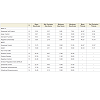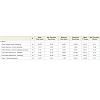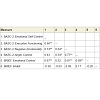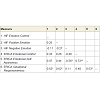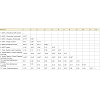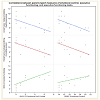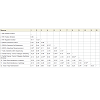Journal of Neurology and Psychology
Download PDF
Special Issue: Clinical Neuropsychology
Research Article
*Address for Correspondence: David A.S. Kaufman, Ph.D., Department of Psychology, Saint Louis University, Morrissey Hall 2739, 3700 Lindell Blvd, St. Louis, MO 63108, USA, E-mail: dkaufma3@slu.edu
Citation: Sudikoff EL, Bertolin M, Lordo DN, Kaufman DAS. Relationships between Executive Function and Emotional Regulation in Healthy Children. J Neurol Psychol. 2015; S(2):8.
Copyright © 2015 Sudikoff EL, et al. This is an open access article distributed under the Creative Commons Attribution License, which permits unrestricted use, distribution, and reproduction in any medium, provided the original work is properly cited.
Journal of Neurology and Psychology | ISSN: 2332-3469 | Special Issue: 2
Submission: 07 October 2014 | Accepted: 27 November 2014 | Published: 03 December 2014
Editors: Dr. David AS Kaufman, Assistant Professor of Psychology, Saint Louis University, USA
Research Article
Relationships between Executive Function and Emotional Regulation in Healthy Children
Eliana L. Sudikoff, Madison Bertolin, Danielle N Lordo, and David A.S. Kaufman*
- Department of Psychology, Saint Louis University, St. Louis, MO, USA
*Address for Correspondence: David A.S. Kaufman, Ph.D., Department of Psychology, Saint Louis University, Morrissey Hall 2739, 3700 Lindell Blvd, St. Louis, MO 63108, USA, E-mail: dkaufma3@slu.edu
Citation: Sudikoff EL, Bertolin M, Lordo DN, Kaufman DAS. Relationships between Executive Function and Emotional Regulation in Healthy Children. J Neurol Psychol. 2015; S(2):8.
Copyright © 2015 Sudikoff EL, et al. This is an open access article distributed under the Creative Commons Attribution License, which permits unrestricted use, distribution, and reproduction in any medium, provided the original work is properly cited.
Journal of Neurology and Psychology | ISSN: 2332-3469 | Special Issue: 2
Submission: 07 October 2014 | Accepted: 27 November 2014 | Published: 03 December 2014
Editors: Dr. David AS Kaufman, Assistant Professor of Psychology, Saint Louis University, USA
Abstract
As an aspect of cognitive control, emotion regulation has been thought to be closely associated with executive functioning. Previously proposed models have indicated that they are bidirectionally linked, suggesting that deficits in one area of functioning may generate deficits in the other. The current study sought to investigate the relationships between executive functioning and emotion regulation in healthy children ages 8-12 by examining associations between standardized measures of executive functioning and emotion regulation. Children were administered neuropsychological and self-report measures of emotion regulation and executive functioning while parents completed behavioral ratings of these abilities. Associations between behavioral ratings and neuropsychological measures indicated that greater proficiency in executive functioning skills was associated with greater emotion regulation capabilities. These findings extend prior work showing that executive functioning and emotion regulation are linked, and may have important implications for treatment planning in clinical populations with weaknesses in these areas.Introduction
Emotions are multifaceted psychological responses, arising from goal-oriented attention [1] and action predispositions [2]. Emotion regulation has been defined by Saarni as the regulation of the experience of emotion by monitoring one’s expressive behavior [3]. This refers to the ability of the individual to modify the intensity, level of arousal, and time course of an emotion in order to meet the goals that the external situation requires [4]. One of the key facets of emotion regulation is the ability to modulate the development of mood disruptions by reducing negative emotional responses [5], which can be automatic or controlled, conscious or unconscious [1].Research on emotion regulation has suggested that as an aspect of cognitive control [6], it is closely associated with executive functioning. Executive functioning can be defined as the deliberate control of thought and action for future thoughts and behaviors [7,8], involving cognitive processes such as planning, working memory, error detection and inhibitory control [9-11]. Moreover, many researchers conceptualize executive functioning as a collection of top-down control processes that are required for all goal-directed behaviors, especially when these behaviors call for inhibiting automatic or established thoughts and responses and when acting on impulse is inadvisable [9,12,13].In the early years of development, children begin to understand emotion through contextual factors such as language development, cultural values, and influence of caregivers. As they mature their understanding of emotion becomes more complex, with the development of cognitive reappraisal to aid them in understanding the complexities of emotion in those around them. Throughout the lifespan, emotion regulation continues to develop, often necessitated by changes in life context, requiring the individual to alter one’s coping style as situations change. Research has indicated that experience plays a primary role in allowing an adult to modulate emotion regulation processes [1].The prefrontal cortex (PFC) undergoes substantial development throughout childhood and into adulthood. Since attentional control is generally associated with the PFC throughout the lifespan [14], this cognitive ability varies considerably by age. Some evidence has suggested that attentional control is associated with more posterior cortical involvement in younger children [15], and neuroimaging research has indicated less PFC activation in adults than in children [16] or adolescents [17] in tasks requiring inhibition or directed attention. Moreover, neuroimaging findings have revealed that children showed a greater volume of PFC activation than adults in a task of working memory [18]. Such changes in activation patterns over time may be due to increasing neural efficacy or developmental changes in synaptic pruning and myelination, which increase cognitive integration and development [17,18].Associations between better self-regulation and higher social functioning in situations of conflict are found as early the preschool stage [19]. Neuroimaging studies suggest that increased attention related neural activity in emotional contexts reflects allocation of cognitive resources for regulatory control [14,20,21]. Such results indicate that children’s difficulties in regulating behaviors in emotional contexts may be the result of competition between well developed emotional processes and poorly developed cognitive control systems [22,23].Deficits in attention and emotion regulation tend to co-occur in many at-risk populations such as those presenting with Attention Deficit/Hyperactivity Disorder (ADHD) [24], and increased attention to distracting negative or ambiguous emotional information has been associated with mood or anxiety disorders [25,26]. These deficits reflect the importance of an appropriately developing frontal lobe to inhibit the depletion of available resources for voluntary emotion regulation [27].Additionally, many investigators link aggressive behavioral difficulties with inadequate or inappropriate emotional regulation [28-30]. Young children who are less able to voluntarily shift attention and inhibit their emotional impulses have been shown to display higher levels of aggression [31]. Furthermore, externalizing and internalizing disorders can be understood as disorders of emotion regulation [32] through difficulty utilizing control, indicating their inability to disengage from the negative emotional content [33,34].The current study investigated the relationship between emotion regulation and executive functioning in healthy children by examining associations between standardized measures of executive functioning and emotion regulation skills. Behavioral indicators of executive and emotional control were assessed using self- and parent report rating scales and objective evaluation of executive function skills. We predicted that behavioral ratings of executive control and emotion regulation would correlate with one another and with objective measures of executive control, particularly inhibition.Methods
ParticipantsParticipants consisted of 15 healthy, typically developing children ages 8-12 years old (11 males, 4 females) and their parents. Child participant age was distributed across the age range, with a mean age of 10 years (SD = 1.5). Chi-square analysis on participant gender and age suggested that gender did not significantly vary as a function of age, χ2 (5.4), p > 0.24. Five sibling pairs were included in the sample. Children with a history of seizures, epilepsy, diagnosed neurological disease, or a family history of epilepsy or seizures were excluded from participation in the study. Additionally, no children were reported to have a history of neurodevelopmental disorders (e.g., Autism Spectrum Disorder or ADHD) or psychiatric diagnoses (e.g., depression or anxiety). IRB approval was acquired prior to the initiation of the study and individual assent and consent wasobtained from all participants. Families were compensated for their participation.Materials and procedureSelect neuropsychological tests from the Delis-Kaplan Executive Functions Scale (D-KEFS) [35] were administered to youth participants in order to assess executive function skills. The D-KEFS is an individually administered neuropsychological battery of tests designed to detect even mild forms of executive dysfunction among clinical populations ages 8-89 years. It was derived from existing experimental and clinical measures and normed on a standardizationsample consisting of 1,750 individuals. For the purposes of the current study, select subtests including D-KEFS Trails, Color-Word Interference, Verbal Fluency, and Tower Task (internal consistency = .60-.89) [35] were administered in a pseudo-randomized order. The outcome variables of interest for Trails (Number-Letter Switching) and Color-Word Interference (Inhibition, Inhibition-Switching) were times to completion, the variables of interest for Verbal Fluency (Category Switching) were number of correct responses and switching accuracy, and the variable of interest for the Tower Test was the total achievement score. Given that the sample consisted of healthy, typically developing children, we chose to focus our analyses on raw scores generated for each measure. One child had incomplete data on the Verbal Fluency subtest.In order to assess emotion regulation skills, children also completed two self-report questionnaires evaluating emotional arousal and control. The Emotion Regulation Index for Children and Adolescents (ERICA) [36] is a 16-item self-report inventory that examines ability to regulate emotions. It is comprised of Emotional Control, Emotional Awareness, and Situational Responsiveness subscales and yields an overall Emotion Regulation Index score. Psychometric evaluation of the ERICA conducted on a sample of 1,389 children ages 9-16 revealed a high Cronbach’s alpha for the overall scale (r = 0.75) and reliability coefficients ranging from 0.64 to 0.73 for the three determined factors (Emotional Control, Emotional Awareness, and Situational Responsiveness) [36]. The How I Feel questionnaire (HIF) [37] is a 30-item self-report inventory that examines aspects of emotional arousal and control that can be brought to consciousness in children. The HIF measures three aspects of emotionality including Positive Emotion, Negative Emotion, and Emotion Control. A psychometric evaluation of the HIF conducted on 1,850 children ages 8-12 revealed high internal consistency estimates ranging from 0.80- 0.90 and good convergent and discriminant validity [37].Finally, to assess practical executive control and emotion regulation skills, parents completed two standardized informant report inventories evaluating various aspects of their child’s behavioral and executive functioning. The Behavior Assessment System for Children Parent Rating Scale (BASC-2 PRS) [38] evaluates broad behavioral functioning in children and adolescents and yieldseight clinical subscales, three clinical composite scores, and four adaptive scales. BASC-2 scales and composites have high internal consistency and test-retest reliability with alpha coefficients for subscales exceeding 0.80 [38]. The BASC-2 PRS has been shown to possess reliabilities for the subscales ranging from 0.80-0.87, as well as good validity established using four separate types of evidence with an additional four indices to measure the validity of parents’ responses [38]. The Behavior Rating Inventory of Executive Function (BRIEF) [39] assesses executive functioning in children and adolescents and yields eight subscales reflecting various facets of executive function, two composite scores, and a global executive composite. The BRIEF was normed on a sample of 1,419 healthy children and an additional clinical sample of 852 children, and was found to demonstrate high internal consistency (r = 0.80- 0.90) and good content validity [39,40].All neuropsychological testing and completion of questionnaires took place at the Cognitive and Affective Psychophysiology (CAP) laboratory at Saint Louis University in St. Louis, Missouri. A qualified research team member administered neuropsychological tests and youth self-report questionnaires in a quiet testing room. The research team member was available to answer questions for youth participants during completion of the self-report questionnaires. Parents of participants completed informant-report inventories in a nearby, adjacent room.Statistical analysesAssessment measure raw scores for each participant were calculated and scored according to the directives of the assessment literature, testing manuals and associated scoring software. Means and standard deviations were calculated for the raw scores of each subscale score. A series of Pearson correlations were conducted among parent (BASC-2 and BRIEF) and child report measures (ERICA and HIF), and objective measures of executive function (D-KEFS: Color-Word Interference Inhibition and Switching scores, Verbal Fluency Correct Category Switching and Category Switching Accuracy scores, Trails Number-Letter Switching score, and Tower total score). For the analyses, square root transformations wereperformed on the following variables, due to violations in normality: BASC-2 Emotional Self-Control, BRIEF Emotional Control, and Color-Word Interference Switching.Results
Initial mean raw scores for all behavioral and performance indicators of executive and emotional control are presented in Tables 1 and 2 . Decreased scores on inventories with negatively-phrased questions, such as the BASC-2, BRIEF, and HIF (Negative Emotion), indicate greater competency in the designated skill area. Alternatively, increased scores on questionnaires with positively-phrased questions, such as the ERICA (Emotion Control, Emotional Self-Awareness, Situational Responsiveness) and HIF (Emotion Control, Positive Emotion), indicate greater skill proficiency. Evaluation of proficiency in executive functioning, as measured by the D-KEFS, varies bysubtest. For the Tower and Verbal Fluency tasks, higher scores indicate greater executive control, whereas for the Trails and Color-Word Interference tasks, lower scores indicate greater proficiency. Parent report of executive functioning and emotion regulationPearson’s correlations between subscales on parent-report measures of executive control indicated that decreased scores on the BASC-2 Emotional Self-Control subscale corresponded as expected with decreased scores on the BRIEF Emotional Control subscale. However, correlations among BASC-2 subscales and the BRIEF Inhibit subscale were non-significant. Additionally, strong positive relationships were found between the BRIEF Emotional Control and BASC-2 Anger Control and Negative Emotionality subscales, further supporting similarities in the constructs as assessed by both measures. Intra-measure subscale correlations indicated moderate to strong positive relationships between the BASC-2 Executive Functioning, Emotional Self-Control, Negative Emotionality, and Anger Control subscales (Table 3). Child report of emotion regulationPearson’s correlations between child-report measures of emotion regulation indicated moderate to strong inter-subscale relationships and strong intra-subscale relationships. Specifically, higher scores on HIF Emotion Control corresponded with higher scores on ERICASituational Responsiveness, and increased ratings of positive emotion, assessed by the HIF Positive Emotion subscale corresponded with higher ratings of ERICA Situational Responsiveness. Intra-measure correlations indicated moderate to strong positive relationships between all ERICA subscales, suggesting adequate construct validity (Table 4). Parent report and objective measures of executive functioningCorrelational analyses between parent-report measures and D-KEFS performance indicators revealed moderate to strong inverse relationships. In contrast to our predictions, Pearson’s correlations between BASC-2 and BRIEF executive control subscales (Emotional Self-Control, Emotional Control, and Inhibit) and performance on the Color-Word Interference task (Inhibition and Inhibition/Switching) were found to be non-significant (Table 5). However, correlations investigating associations between BASC-2 and BRIEF executive and emotional control subscales and performance on the Verbal Fluency task revealed several significant relationships. Higher scores (number of correct responses) on the Verbal Fluency task were related to lower scores on the BASC-2 Negative Emotionality, Emotional Self-Control, and Anger Control subscales. Similarly, better switching accuracy on the Verbal Fluency task corresponded with lower scores on the BASC-2 Negative Emotionality, Emotional Self-Control, and Executive Functioning subscales. Finally, decreased scores on the BRIEF Emotional Control subscale were related to better performance (number of correct responses and switching accuracy) on the Verbal Fluency task. These relationships can be seen in Table 5 and Figure 1.
Child report and objective measures of executive functioningPearson’s correlations between self-report measures of emotion regulation and D-KEFS performance indicators revealed several significant relationships. In line with our hypotheses, correlations among the HIF, ERICA, and Color-Word Interference task indicated that higher scores on the ERICA Situational Responsiveness subscale were related to better performance on Color-Word Interference (Switching). Similarly, higher scores on the ERICA Emotional Self- Awareness subscale were also related to better performance on the Color-Word Interference task (Inhibition). Additional exploratory correlations conducted among other D-KEFS performance indicators showed that higher scores on the ERICA Emotional Self-Awareness subscale correlated with better performance on Verbal Fluency (number of correct responses and switching accuracy). Additionally, decreased scores on the HIF Negative Emotion subscale corresponded with greater proficiency in switching accuracy on the Verbal Fluency task (Table 6). In summary, our prediction that behavioral ratings of executive control and emotion regulation would correlate with one another and with objective measures of executive control, particularly inhibition, was partially supported. Correlations between behavioral ratings and performance indicators of executive functioning revealed significant associations among parent ratings of executive functioning and emotion regulation, among child ratings of emotion regulation, and among parent and child behavioral ratings and performance indicators of executive functioning (D-KEFS Verbal Fluency and Color-Word Interference). No significant relationships were found between parent- and child-report measures.
Discussion
This study investigated relationships between executivefunctioning and emotion regulation in a sample of healthy, typically developing children. The main objective was to determine the nature of the relationship between emotion regulation and executive control through self- and parent-report behavioral ratings and objective neuropsychological measures of these abilities. Associations between behavioral ratings and neuropsychological measures observed in the current study suggest broadly that enhanced executive function skills may be associated with greater emotion regulation capabilities. Taken together, these results help to clarify bidirectional associations underlying the relationship between executive and emotional control.Neuropsychological evidence of relationships between executive functioning and emotion regulationConsistent with our hypothesis that behavioral ratings of executive control and emotion regulation would correlate with one another and with objective measures of executive control, significant associations between behavioral ratings of executive functioning and emotion regulation and objective measures of executive functioning were observed. Broadly speaking, BASC-2 indicators of executive control and emotion regulation correlated with one another, indicating that report of better executive function skills is associated with better reported emotion regulation abilities. Additionally, although our hypothesis that behavioral ratings of executive control and emotion regulation would correlate with objective measures of inhibition was not supported, additional analyses examining other facets of executive functioning illuminated several important relationships. First, parent endorsement of greater executive control and emotion regulation skills was generally associated with better performance on tasks measuring executive functioning. Second, child endorsement of better emotion regulation skills was found to be indicative of better executive control. Of note, parent- and child-report measures did not correlate with one another. Given that they both demonstrated similar trends in their relationships with D-KEFS measures, this lack of convergence may be attributable to wording differences between the questionnaires.As previously described, the relationships between executive and emotional control have been widely discussed in the literature. Barkley suggested that inhibitory functions, comprised of many factors including self-regulation of affect, are fundamental forefficient executive functioning [24]. More specifically, the ability to self-regulate or bring about emotional states in order to support goaldirected behaviors requires the incorporation of greater executive functioning. Zelazo and Cunningham and Carlson and Wang created models that determined that executive function and emotion regulation demonstrate bi-directional relationships [41,42], implying that deficits in one area may lead to deficits in the other.Results of the current study support this conceptualization of the relationship between executive functioning and emotion regulation, namely that better skills in one area are associated with better skills in the other. Although our results are limited to healthy children who do not display clinically significant executive or emotion control deficits, further research examining the nature of this relationship in clinical populations is warranted.Possible Limitations
The current study has several limitations which must be considered. First, the uniform characteristics of our healthy sample yielded a lack of variability in the results. Despite being recruited from the greater St. Louis community, the majority of participantsreported a moderate to high SES background, with high levels of educational achievement in both children and their parents. As a result, performance on neuropsychological measures was very high across participants and tasks, with very little variability in the raw scores. It should also be noted that there was a large number of sibling pairs in the study, which might have further skewed the data if the participants shared heritable traits. Additionally, although analyses suggested that gender did not vary by age, the large difference in the number of males and females in the study may also limit the representativeness of the sample.For this preliminary study, in order to better control for task difficulty and response variability on the rating forms, our sample was kept relatively homogenous with regard to participant age and background. This did not include restricting gender; however, few female children indicated interest in participating in the study. In order to better understand these suggested relationships, further research is warranted to better explore these relationships in a more diverse child population with greater equality of gender distribution. Moreover, recruitment of additional participants would serve to increase the power of the study, given that the current sample size was notably small.Second, it was observed that parent and child report measures of executive function and emotion regulation did not correlate with one another, despite having similar associations with objective measures of executive functioning. This may be accounted for by the potential confound that parent measures were negatively worded (e.g. “Losestemper too easily”), while child reports were positively worded (e.g. “I was in control of how often I felt excited”). Further investigation of the discrepancy between child and parent report is warranted and future studies may benefit from selecting questionnaires with consistent phrasing.Third, specific parent and child characteristics may have impacted performance on measures or subject report. Parent reports might have been susceptible to the Desirability Effect, such that parents might have under-reported any difficulties with emotion regulationor executive functioning skills. Similarly, some children might have likewise been hesitant to answer all questions with complete honesty if the answers were viewed as less socially desirable. Furthermore, confounds such as fatigue, confusion, or boredom may also have impacted child participant results.Future Directions
The results of this study clearly highlight relationships between executive control and emotion regulation, suggesting that better executive function skills are associated with more proficient emotion regulation skills. Relatedly, these findings also suggest that deficits in one area may lead to impaired functioning inthe other. As previous studies have suggested, poor emotion regulation has been associated with lower levels of effortful control [43]. Moreover, deficits in both effortful control and emotion dysregulation represent core impairments characteristic of a variety of internalizing and externalizing disorders including ADHD, mood disorders, and anxiety disorders [24-26,32-34]. Given consistently observed relationships between executive functioning and emotion regulation, such as those described in the current study, it is likely that associations between executive control and behavioral deficits in psychiatric and neurological disorders are also linked to deficits in emotion regulation.Summary
The current study investigated the relationships between executive functioning and emotion regulation in healthy children ages 8-12 by examining associations between standardized measures of executive functioning and emotion regulation. Associations between behavioral ratings and neuropsychological measures of executive functioning revealed that more proficient executive functioning skills wereassociated with enhanced emotion regulation abilities. Broadly, these findings illustrate that better executive functioning is associated with enhanced emotion regulation, which when taken together with prior literature, may suggest that impairments of both processes are also linked. Better understanding of this relationship may help elucidate mechanisms underlying clinical disorders characterized by deficits in both executive and emotional control. These findings extend prior work demonstrating that executive functioning and emotion regulation are linked, and may have important implications for treatment planning in clinical populations with converging deficits in these areas.References
- Gross JJ, Thompson RA (2007) Emotion regulation: Conceptual foundations. In: JJ Gross (Ed), Handbook of Emotion Regulation. New York, NY: The Guilford Press, pp. 3-24.
- Lang PJ (1995) The emotion probe: Studies of motivation and attention. Am Psychol 50: 372-385.
- Saarni C (1984) An observational study of children’s attempts to monitor their expressive behavior. Child Dev 55: 1504-1513.
- Thompson RA (1994) Emotional regulation: a theme in search of a definition. Monogr Soc Res Child Dev 59: 25-52.
- Cole PM, Martin SE, Dennis TA (2004) Emotion regulation as a scientific construct: methodological challenges and directions for child development research. Child Dev 75: 317-333.
- Ochsner KN, Ray RD, Cooper JC, Robertson ER, Chopra S, et al. (2004) For better or for worse: neural systems supporting the cognitive down-and up-regulation of negative emotion. Neuroimage 23: 483-499.
- Roberts AC, Robbins TW, Weiskrantz, LE (1998) The prefrontal cortex: executive and cognitive functions. Oxford: Oxford University Press.
- Stuss DT, Benson DF (1986) The Frontal Lobes. New York: Raven Press.
- Diamond A (2013) Executive functions. Ann Rev Psychol 64: 135-168.
- Welsh MC, Pennington BF, Groisser DB (1991) A normative‐developmental study of executive function: A window on prefrontal function in children. Dev Neuropsychol 7: 131-149.
- Zelazo PD, Carter A, Reznick JS, Frye, D (1997) Early development of executive function: A problem-solving framework. Rev Gen Psychol 1: 198-226.
- Casey BJ, Tottenham N, Fossella J (2001) Clinical, imaging, lesion, and genetic approaches toward a model of cognitive control. Dev Psychobiol 40: 237-254.
- Roberts RJ, Pennington BF (1996) An interactive framework for examining prefrontal cognitive processes. Dev Neuropsychol 12: 105-126.
- Lewis MD, Lamm C, Segalowitz SJ, Stieben J, Zelazo PD (2006) Neurophysiological correlates of emotion regulation in children and adolescents. J Cogn Neurosci 18: 430-443.
- Bunge SA, Dudukovic NM, Thomason ME, Vaidya CJ, Gabrieli JD (2002) Immature frontal lobe contributions to cognitive control in children: evidence from fMRI. Neuron 33: 301-311.
- Durston S, Thomas KM, Yang YH, Ulug AM, Zimmerman, RD, et al. (2002) A neural basis for the development of inhibitory control. Dev Sci 5: F9-F16.
- Luna B, Thulborn KR, Munoz DP, Merriam EP, Garver KE, et al. (2001) Maturation of widely distributed brain function subserves cognitive development. Neuroimage 13: 786-793.
- Casey BJ, Giedd JN, Thomas KM (2000) Structural and functional brain development and its relation to cognitive development. Biol Psychol 54: 241-257.
- Eisenberg N, Fabes RA, Shepard SA, Murphy BC, Guthrie IK, et al. (1997) Contemporaneous and longitudinal prediction of children's social functioning from regulation and emotionality. Child Dev 68: 642-664.
- Gray JR, Burgess GC, Schaeper A, Yarkoni T, Larson RJ, et al. (2005) Affective personality differences in neural processing efficiency confirmed using fMRI. Cogn Affect Behav Neurosci 5: 182-190.
- Luu P, Tucker DM, Makeig S (2004) Frontal midline theta and the error-related negativity: neurophysiological mechanisms of action regulation. Clin Neurophysiol 115: 1821-1835.
- Hare TA, Tottenham N, Davidson MC, Glover GH, Casey BJ (2005) Contributions of amygdala and striatal activity in emotion regulation. Biol Psychiatry 57: 624-632.
- Hare TA, Tottenham N, Galvan A, Voss HU, Glover GH, et al. (2008) Biological substrates of emotional reactivity and regulation in adolescence during an emotional go-nogo task. Biol Psychiatry 63: 927-934.
- Barkley RA (1997) Behavioral inhibition, sustained attention, and executive functions: constructing a unifying theory of ADHD. Psychol Bull 121: 65-94.
- Compton RJ (2003) The interface between emotion and attention: a review of evidence from psychology and neuroscience. Behav Cogn Neurosci Rev 2: 115-129.
- Derryberry D, Reed MA (2002) Anxiety-related attentional biases and their regulation by attentional control. J Abnorm Psychol 111: 225-236.
- Bishop S, Duncan J, Brett M, Lawrence AD (2004) Prefrontal cortical function and anxiety: controlling attention to threat-related stimuli. Nat Neurosci 7: 184-188.
- Eisenberg N, Cumberland A, Spinrad TL, Fabes RA, Shepard SA, et al. (2001) The relations of regulation and emotionality to children's externalizing and internalizing problem behavior. Child Dev 72: 1112-1134.
- Eisenberg N, Ma Y, Chang L, Zhou Q, West SG, et al. (2007) Relations of effortful control, reactive undercontrol, and anger to Chinese children's adjustment. Dev Psychopathol 19: 385-409.
- Zhou Q, Hofer C, Eisenberg N, Reiser M, Spinrad TL, et al. (2007) The developmental trajectories of attention focusing, attentional and behavioral persistence, and externalizing problems during school-age years. Dev Psychol 43: 369-385.
- Rothbart MK, Ahadi SA, Hershey KL (1994) Temperament and social behavior in childhood. Merrill-Palmer Quarterly 40: 21-39.
- Calkins SD (1994) Origins and outcomes of individual differences in emotion regulation. Monogr Soc Res Child Dev 59: 53-72.
- Eisenberg N, Fabes RA, Shepard SA, Guthrie IK, Murphy BC, et al. (1999) Parental reactions to children's negative emotions: Longitudinal relations to quality of children's social functioning. Child Dev 70: 513-534.
- Eisenberg N, Hofer C, Vaughan J (2009) Effortful control and its socioemotional consequences. In: Gross JJ (Ed), Handbook of Emotion Regulation. New York, NY: The Guilford Press, pp. 287-306.
- Delis DC, Kaplan E, Kramer JH (2001) Delis-Kaplan Executive Function System™ (D-KEFS™). Psychological Corporation.
- MacDermott ST, Gullone E, Allen JS, King NJ, Tonge B (2010) The emotion regulation index for children and adolescents (ERICA): a psychometric investigation. J Psychopathol Behav Assess 32: 301-314.
- Walden TA, Harris VS, Catron TF (2003) How I feel: a self-report measure of emotional arousal and regulation for children. Psychol Assess 15: 399-412.
- Reynolds CR, Kamphaus RW (2004) Behavior Assessment System for Children, Second Edition (BASC–2). Circle Pines, MN: American Guidance Service.
- Gioia GA, Isquith PK, Guy SC, Kenworthy L (2000) Behavior rating inventory of executive function® (BRIEF®). Odessa, FL: Psychological Assessment Resources.
- Strauss EH, Sherman EM, Spreen O (2006) A compendium of neuropsychological tests: Administration, norms, and commentary. Oxford University Press.
- Zelazo PD, Cunningham WA (2007) Executive function: Mechanisms underlying emotion regulation. In: JJ Gross (Ed) Handbook of Emotion Regulation. New York, NY: The Guilford Press, pp. 135-158.
- Carlson SM, Wang TS (2007) Inhibitory control and emotion regulation in preschool children. Cogn Dev 22: 489-510.
- Eisenberg N, Spinrad TL (2004) Emotion-related regulation: sharpening the definition. Child Dev 75: 334-339.


